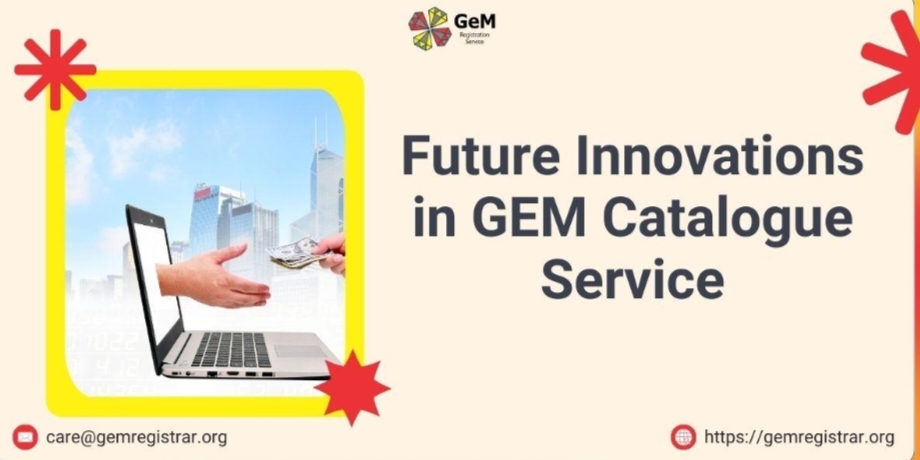Introduction
The Government e-marketplace (GEM) has revolutionized the procurement process by providing a unified and transparent platform for government buyers and sellers. As we look to the future, continuous innovation in the GEM Catalogue Service is essential to enhance user experience, improve efficiency, and foster greater transparency. This document outlines the future innovations that can be integrated into the GEM Catalogue Service to achieve these goals.
1. AI-Driven Product Recommendations
Leveraging artificial intelligence (AI) to provide personalized product recommendations can greatly enhance the user experience. By analyzing past purchase behaviors and preferences, AI can suggest relevant products to buyers, streamlining the procurement process and ensuring that users find the best products to meet their needs.
2. Enhanced Search and Filter Capabilities
Improving the search and filter capabilities of the GEM Catalogue can make it easier for users to find exactly what they are looking for. Advanced search algorithms, natural language processing, and dynamic filtering options will allow users to quickly narrow down their options based on specific criteria such as price, vendor ratings, delivery time, and more.
3. Real-Time Inventory Updates
Integrating real-time inventory updates into the GEM Catalogue Service will provide buyers with accurate information about product availability. This will help avoid procurement delays and ensure that users can make informed purchasing decisions based on the most current data.
4. Blockchain for Enhanced Transparency
Incorporating blockchain technology can enhance transparency and traceability in the procurement process. Blockchain can provide an immutable record of transactions, ensuring that all procurement activities are auditable and tamper-proof. This can increase trust among users and reduce the risk of fraud.
5. Supplier Performance Analytics
Providing detailed analytics on supplier performance can help buyers make more informed decisions. By analyzing metrics such as delivery times, product quality, and customer feedback, the GEM Catalogue Service can highlight top-performing suppliers and identify areas for improvement.
6. Integration with IoT for Smart Procurement
Integrating the Internet of Things (IoT) with the GEM Catalogue Service can enable smart procurement practices. For example, IoT devices can monitor inventory levels in real-time and automatically trigger purchase orders when stock runs low. This can ensure timely replenishment and reduce the risk of stockouts.
7. User-Friendly Mobile Application
Developing a user-friendly mobile application for the GEM Catalogue Service can make it more accessible to users on the go. The app can offer features such as barcode scanning, voice search, and push notifications to keep users informed about order status and new product listings.
8. Sustainability and Green Procurement
Promoting sustainability and green procurement within the GEM Catalogue Service can align with global environmental goals. By highlighting eco-friendly products and encouraging suppliers to adopt sustainable practices, GEM can contribute to a greener future.
9. Enhanced Security Measures
Implementing advanced security measures such as multi-factor authentication, encryption, and regular security audits can protect user data and prevent cyber threats. Ensuring the security of the GEM Catalogue Service is crucial to maintaining user trust and safeguarding sensitive information.
10. Customer Support and Chatbots
Enhancing customer support through the use of chatbots and AI-driven assistance can provide users with immediate help and guidance. Chatbots can answer common queries, assist with navigating the platform, and escalate issues to human support when necessary.
11. Predictive Analytics for Demand Forecasting
Integrating predictive analytics can revolutionize how procurement decisions are made. By analyzing historical data, market trends, and seasonal variations, the GEM Catalogue Service can forecast future demand for various products. This enables government buyers to plan and budget more effectively, reducing the risk of stock shortages and overstock situations.
12. Automated Compliance Checks
Automated compliance checks can ensure that all procurement activities adhere to regulatory standards and policies. By embedding compliance rules within the GEM Catalogue Service, the platform can automatically validate procurement requests, vendor qualifications, and product certifications, ensuring that all transactions meet the required legal and regulatory frameworks.
13. Enhanced Vendor Collaboration Tools
Facilitating better collaboration between buyers and vendors can lead to more efficient procurement processes. Enhanced communication tools, such as integrated messaging systems, video conferencing, and shared project management platforms, can improve coordination, reduce misunderstandings, and expedite the resolution of issues.
14. Integration with E-Invoicing Systems
Seamlessly integrating the GEM Catalogue Service with e-invoicing systems can streamline the payment process. This integration can automate the generation, submission, and approval of invoices, reducing manual effort, minimizing errors, and ensuring timely payments to vendors.
15. Customizable User Dashboards
Offering customizable user dashboards can provide a more personalized and efficient experience. Users can tailor their dashboards to display relevant information, such as order statuses, recent purchases, supplier ratings, and upcoming procurement needs, allowing them to manage their activities more effectively.
16. Multi-Language Support
To cater to a diverse user base, implementing multi-language support within the GEM Catalogue Service can enhance accessibility and usability. Providing the platform in multiple languages ensures that users from different linguistic backgrounds can navigate and utilize the service with ease.
17. Virtual and Augmented Reality (VR/AR) for Product Demonstrations
Incorporating VR and AR technologies can provide immersive product demonstrations and inspections. Buyers can virtually examine products, visualize them in real-world settings, and make more informed decisions without the need for physical samples, thus saving time and resources.
18. Dynamic Pricing Models
Introducing dynamic pricing models can optimize procurement costs. By leveraging real-time data and market conditions, the GEM Catalogue Service can offer flexible pricing strategies, such as volume discounts, seasonal offers, and promotional deals, providing cost savings and value for money.
Conclusion
The future of the GEM Catalogue Service lies in continuous innovation and the integration of advanced technologies. By focusing on AI, blockchain, IoT, and enhanced user experience, GEM can further streamline the procurement process, promote transparency, and foster a more efficient and user-friendly platform. Embracing these innovations will ensure that GeM Registration remains at the forefront of government procurement solutions, setting a standard for excellence and reliability.
These innovations aim to position the GEM Catalogue Service as a cutting-edge platform, meeting the evolving needs of its users and setting a benchmark for e-procurement systems globally.



